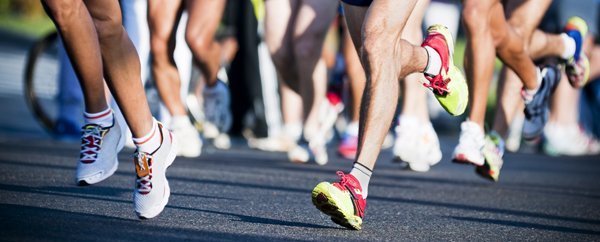Heel Striking: Root Of All Evil

Many runners are still being told by shoe shop staff, personal trainers or other therapists that the way to become a better runner and/or avoid injury is to change their heel strike to a midfoot or forefoot strike. Unfortunately, it’s not that simple and despite the good intention it is delivered with, advice like this can even cause injury.
Why is Heel Striking seen as bad?
The rise in popularity for barefoot running and minimalistic footwear brought about in particular by the publication of Chris McDougall’s best-selling novel ‘Born To Run’ in 2009 stimulated debate on not only what we should wear on our feet when running but also what part of the foot should touch the ground first – the heel, the midfoot or the forefoot.
Unfortunately, passion and enthusiasm for this fresh way of looking at running led to a lot of ‘personal’ experience being pushed as ‘fact’ and careful selection & interpretation of some research being promoted as ‘scientific evidence’ that to become a stronger and more injury free runner you need to wear as little as possible on your feet and land on the midfoot or forefoot.
The fact that no such scientific evidence exists hit home in 2014 when Vibram, who launched their popular FiveFingers shoes in 2009, ended up paying a $3.75 million settlement agreement in a class action lawsuit that accused them of making false claims about the health benefits of FiveFingers shoes. Vibram agreed not to make any further claims of such health benefits until “competent and reliable scientific evidence” substantiates such claims.
Is Heel Striking Less Efficient?
Claims that heel striking is ‘inefficient’ for distance runners are likewise unfounded. In fact, most scientific studies measuring foot strike patterns show the opposite – for the vast majority of runners (especially sub-elite and recreational runners), heel striking is the most metabolically efficient form of running over long distances.
Dr. Pete Larson, self confessed running shoe addict, creator of highly recommended website Runblogger and author of best seller “Tread Lightly: Form, Footwear, and the Quest for Injury-Free Running, carried out a study at the 2009 Manchester City Marathon. Using a high speed camera, Larson filmed runners at the 10km and 32km points of the race, and later classified them according to their foot strike:
At the 10K mark, 936 runners were noted:
• Heel strike: 88.9%
• Midfoot: 3.4%
• Forefoot: 1.8%
At the 32K mark, 286 of the same runners were noted:
• Heel strike:93%
• Forefoot: 0%
Should we be trying to convert those 800+ heel striking marathon runners to a midfoot or forefoot strike or is it more likely their bodies were automatically choosing the most metabolically efficient way to complete the course?
Overstriding
The results of Larson’s study clearly show that heel striking is not an issue. Research concludes that rather than fixating on what part of the foot touches the ground first, it’s more a question of looking at how far in front of you that foot lands. The mechanics of walking involve swinging a leg out in front of us and landing on a straight leg and knee. As a result, it is invariably the heel that touches the ground first. In contrast, the increased velocity and loads involved in running mean that landing on a straight leg out in front us not only reduces efficiency but as research has shown lead to an overload on the knee and injury. As speed and demand increases, so does the need to land progressively closer to the hips, promoting less ground contact time and a faster leg turnover (cadence).
Changing what part of your foot touches the ground will not change how far in front of you your foot lands. You can easily land on your midfoot or forefoot and still overstride. More importantly, forcing a midfoot or forefoot strike that your body is either not ready for or not designed for can lead to a whole host of new injuries, particularly for the calves and Achilles.
Learning how to land closer to your body using cadence training is a valid coaching tool and often sees as a consequence a movement away from heel strike and towards midfoot… but it happens in that order not the other way round, and the degree of change will vary from runner to runner. You may start landing closer to the body but still land on your heel. This type of heel strike on a bent knee is often referred to as a “glancing” or “proprioceptive” heel strike and should not be cause for concern or preoccupation. The majority of heel strikes seen in Larson’s study could well have been these, so no need to start telling 800+ marathon runners that they were doing it wrong!
Conclusion
So there you have it. Despite the prevailing misconception, heel striking is not the root of all evil. Overstriding, in contrast, has been linked to running related injury of the knee and hip. If you typically run at paces faster than 10 minute miles and discover your cadence is lower that 160spm, you may benefit from incorporating some cadence drills into your weekly runs, as long as you don’t turn into a shuffler… but that’s a topic for a whole new article!
Have you been told your issues are connected to heelstriking? What were you told to do? Did it help? As always, we’d love to hear from you in the comments section below!
Related Posts
Understanding Pain: The Basics
Do you (or a family member/ friend) suffer from pain that has persisted for over 3 months? Has resting / doing rehab exercises not really...
Which Therapist: Factors To Consider
Choosing a suitable health professional can be time consuming and also very expensive, especially if after getting ‘treated’ the pain returns. To...
Outer Hip Pain (GTPS)
Do you feel outer hip pain either during or after running? Does it also sometimes hurt when you cross your legs or sleep on your side? If so, read...





0 Comments
Trackbacks/Pingbacks